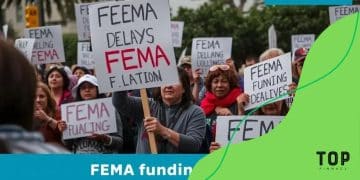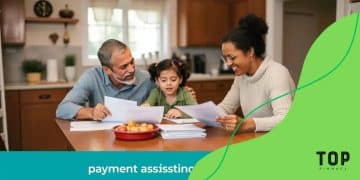Mortgage relief for disaster survivors: what you need to know
Mortgage relief for disaster survivors includes various programs and resources that assist individuals in managing their mortgage payments and recovering financially after experiencing a disaster.
Mortgage relief for disaster survivors is essential during life-changing events. Have you ever wondered how communities bounce back? This article dives into the help available for those affected.
Understanding mortgage relief options
Mortgage relief options are essential for those needing assistance. Understanding these choices can help you find the right support.
Types of mortgage relief options
There are several types of mortgage relief options available for disaster survivors. These include programs aimed at providing immediate assistance and long-term solutions.
- Loan modifications
- Forbearance agreements
- Refinancing opportunities
- Debt forgiveness programs
Each option has its benefits. Loan modifications can lower your monthly payments and make your mortgage more affordable. Meanwhile, forbearance agreements allow you to pause your payments temporarily, helping you regain your financial footing.
Who is eligible?
Eligibility for these programs can vary based on several factors. Typically, you must demonstrate a recent hardship and provide documentation to support your request. It’s important to act quickly, as some programs have deadlines that need to be met.
The application process may seem daunting, but understanding what is needed can ease your path. Gather your financial documents and proof of your situation to make the process smoother. Remember, you are not alone.
In addition, many resources are available to guide you throughout the application process. Always reach out to your lender or local housing authorities for assistance.
Eligibility criteria for disaster survivors
Eligibility criteria for disaster survivors seeking mortgage relief are crucial to understand. Knowing if you qualify can greatly impact your recovery process.
Basic requirements
Each program has specific criteria, but generally, you need to demonstrate a direct impact from a disaster. This may include loss of income, property damage, or additional expenses incurred due to the disaster.
- Proof of identity and residency
- Documentation of income loss
- Evidence of property damage
- Application for assistance within set deadlines
Every detail matters, and being thorough with your documentation can improve your chances of receiving aid. The faster you provide the necessary information, the sooner you can access support.
Special considerations
Some programs may have additional requirements tailored to specific disasters. For example, if a natural disaster has been declared, you may be eligible for enhanced support. However, those who have lost their homes are often given priority.
Being informed about these distinctions can help you navigate the application process more effectively. If you’re unsure about your eligibility, contact your local housing authority for guidance.
Applying for mortgage relief assistance

Applying for mortgage relief assistance can seem challenging, but understanding the steps can simplify the process. It is vital to be prepared.
Gather necessary documents
Before applying, you need to collect specific documents that prove your eligibility. This includes financial statements, proof of income, and documentation of your disaster impact.
- Recent pay stubs or tax returns
- Bank statements
- Insurance claims or estimates of damage
- Identification and residency proof
Having these documents ready will help speed up your application. The more organized you are, the better your chances are for approval.
Steps to apply
The application process generally follows a standard procedure. First, contact your mortgage lender to express your need for relief. They can guide you on the specific forms required.
Next, fill out the application completely and accurately. Be honest about your situation. After submission, follow up regularly to check the status. This keeps your case on their radar and shows your commitment.
Additionally, if you need help, do not hesitate to reach out to local housing authorities or nonprofit organizations that assist with the application process. They can provide valuable resources and support.
Key programs and resources available
Key programs and resources available for disaster survivors are essential for accessing mortgage relief. These programs can greatly ease financial burdens after a disaster.
Federal programs
The federal government offers several programs designed to assist homeowners in distress. One such program is the Federal Housing Administration (FHA) disaster relief, which helps homeowners by providing access to low-interest loans and payment options.
- FHA 203(h) loans for rebuilding
- FEMA assistance for housing needs
- Small Business Administration (SBA) disaster loans
- HUD’s Community Development Block Grant Program
These resources are vital for disaster survivors to secure financial stability. Make sure to explore all options available to you.
Local and state resources
In addition to federal programs, many states have local resources tailored to meet the needs of their residents. Community organizations often provide vital support during recovery.
These resources may include financial assistance programs, legal aid, and housing counseling services. It is beneficial to connect with local non-profits that specialize in recovery efforts.
For those needing immediate help, local housing authorities can offer guidance on options available in your area. Reach out early to access support as soon as possible.
Tips for financial recovery after a disaster
Tips for financial recovery after a disaster are essential for rebuilding your life. Knowing how to manage your finances can make a significant difference.
Assess your situation
The first step is to evaluate your financial situation. Take stock of what you have and what you need. This includes assets, debts, and any insurance payouts you may expect.
- Make a detailed list of all expenses.
- Identify critical needs versus non-essential expenses.
- Consider potential income sources.
- Track all your losses for insurance claims.
Understanding your financial landscape allows you to create a clear recovery plan. Prioritize your spending to ensure survival and stability.
Budget wisely
Creating a budget is crucial during recovery. A well-structured budget helps you control your spending and allocate resources where they’re most needed.
Consider cutting unnecessary expenses. Use any financial relief you receive to cover immediate needs and gradually rebuild your savings. Stay disciplined about your spending habits to avoid falling back into debt.
Moreover, it’s important to adjust your budget as your situation changes. Keep it flexible to accommodate new needs or unexpected expenses.
FAQ – Frequently Asked Questions about Mortgage Relief for Disaster Survivors
What is mortgage relief for disaster survivors?
Mortgage relief for disaster survivors includes various programs and assistance designed to help individuals manage their mortgage payments after experiencing a disaster.
How can I find out if I am eligible for mortgage relief?
Eligibility varies by program, but generally, you need to demonstrate financial impact from a disaster. Check with your lender or local housing authority for specific criteria.
What documents do I need to apply for mortgage relief?
You typically need to provide financial statements, proof of income, documentation of your disaster impact, and identification to apply for assistance.
Where can I access resources for financial recovery?
Resources are available through federal programs like FHA and FEMA, as well as local community organizations that can provide support and guidance during your recovery.






